人教PEP六年级英语上册 Unit 1 第五课时 教案
- 格式:doc
- 大小:28.00 KB
- 文档页数:5

人教版pep小学英语六年级上册_新pep小学英语六年级上册教案(优秀8篇)新pep小学英语六年级上册教案篇一教学目标知识目标:能够进行物品归属的问话与答语,并能根据物体的远近,正确使用this和that。
能力目标:能听懂,会说要求的单词和句子情感价值:进一步提高对英语学习的热情,培养更加稳定的学习兴趣。
能积极主动地参与课堂活动,在情景对话中大胆开口,主动模仿。
教学重点学习和练习正确书写四会单词和四会句子。
教学难点正确使用代词this和that。
课时数 2教学过程 1.热身 / 复习(Warming-up / Revision)1)播放课本附录中的歌曲I want to be your friend, 渲染课堂气氛。
2)把小动物面具挂在墙上,让学生说出它们是什么动词,是谁的。
2.新课导入(Presentation)1)展示本课教学挂图,让学生观察,并提出问题:What are Peter and Lisa doing?What are they talking about?2)播放本课录音,让学生听,然后讨论自己的猜测是否正确。
3)再放录音,让学生仔细听:谁扮演bear?谁的头饰找不到了?最后找到了吗?4)指导学生跟读录音。
5)让学生四人一组分角色表演会话。
6)鼓励学生戴面具到讲台上来表演。
3.趣味操练(Practice)1)教师将全班划分成6~8个小组,每组发一张白纸,每张白纸的最上面都写有“失物招领处”。
要求每组画出3~4种物品,供其它组认领。
2)每组分成两部分,一部分当失主去其它组找丢失物品,另一部分留在本组提供物品。
用所学句型进行交际活动。
3)播放本课投影片,让学生边看边配音。
4. 拓展活动(Additional activities)1)回家听本课录音,模仿语音语调。
2)把本课对话改编或故事,讲给父母听。
课后反思新pep小学英语六年级上册教案篇二教学功能:Talking about past activitiesTarget Language: Did you…?Yes, I did. / No, I didn’t.教学目标:Vocabulary: dear, met (meet), ran (run)Pronunciation: /i:/, /I/, /e/, / /Song: Where did you go?教学过程:一、Warm-up1. Review verb phrases.2. Review Unit 1.二、Introduction1. Prepare a postcard with a picture of own city and ask the children: What’s this? What is the place? What can you see?2. Show the back of the postcard and tell the children that Lingling wrote a letter on it.三、Presentation1. Play the cassette and pause after each utterance for the children to repeat and tick the actions: went to the park, met John, bought ice creams, went home, ran to the bus, dropped.2. Play the cassette again and ask the children answer the following questions: Who wrote the postcard? Whom did Lingling send the postcard to?3. Write down the words: met, bought, went, ran, dropped and ask the children to guess the original form.4. Finish activity 2. Ask the children to ask and answer in pairs.四、Sing a song1. Ask the children to look at the pictures carefully.2. Play the cassette and ask the children to listen carefully.3. Teach the sentences of the song one by one.4. Play the cassette several times and ask the children to sing along.五、Homework1. Read the letter and sing the song.2. Finish activity 6: sentence relay.2021版pep小学英语六年级上册教案篇三单元教学目标1、能力目标(1)能听懂会说认读本单元关于形容词比较级的单词。
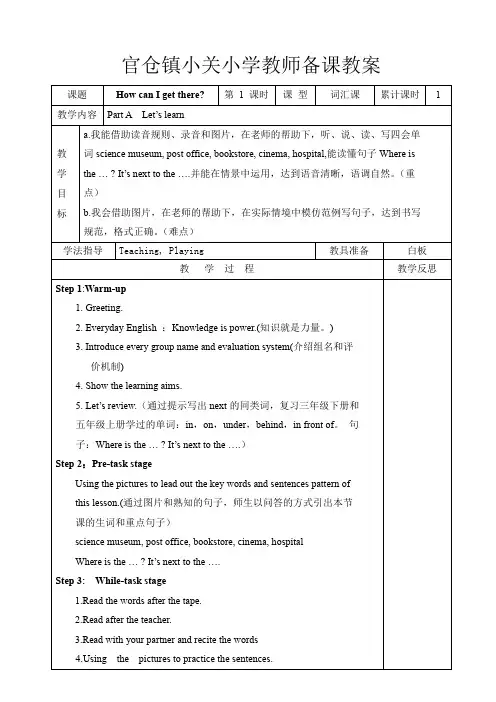
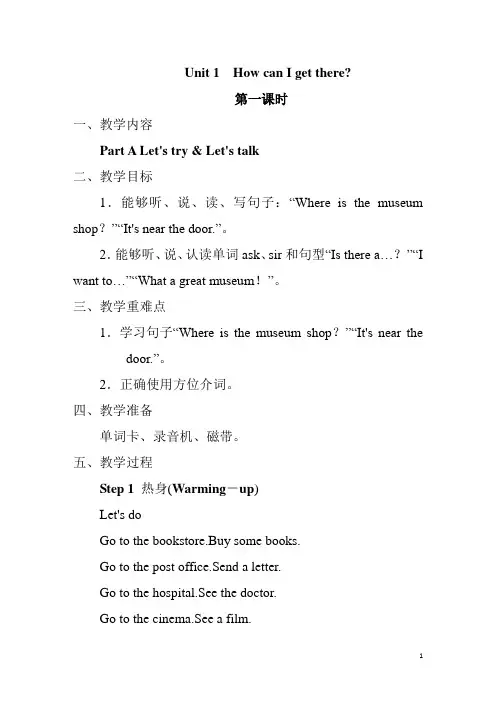
Unit 1How can I get there?第一课时一、教学内容Part A Let's try & Let's talk二、教学目标1.能够听、说、读、写句子:“Where is the museum shop?”“It's near the door.”。
2.能够听、说、认读单词ask、sir和句型“Is there a…?”“I want to…”“What a great museum!”。
三、教学重难点1.学习句子“Where is the museum shop?”“It's near the door.”。
2.正确使用方位介词。
四、教学准备单词卡、录音机、磁带。
五、教学过程Step 1 热身(Warming-up)Let's doGo to the bookstore.Buy some books.Go to the post office.Send a letter.Go to the hospital.See the doctor.Go to the cinema.See a film.Go to the museum.See some robots.Step 2 新课呈现(Presentation)1.学习Let's try(1)打开课本读一读Let's try中呈现的问题和选项。
(2)播放录音,让学生听完后勾出正确的选项。
(3)全班核对答案。
2.学习Let's talk(1)播放Let's talk的录音,学生带着问题听录音:Where is the museum shop?Where is the post office?听完录音后让学生回答这两个问题,教师板书:It's near the door.It's next to the museum.教师讲解:near表示“在附近”,next to表示“与……相邻”,它的范围比near小。
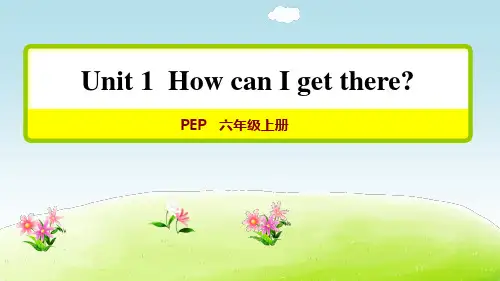
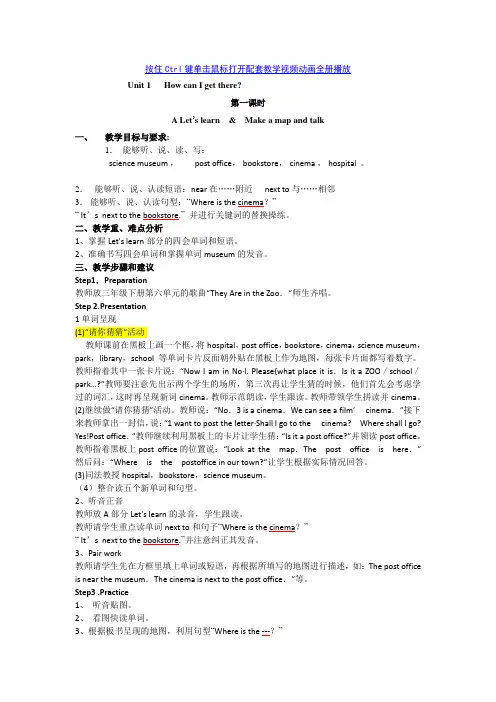
按住Ctrl键单击鼠标打开配套教学视频动画全册播放Unit 1 How can I get there?第一课时A Let’s learn & Make a map and talk一、教学目标与要求:1.能够听、说、读、写:science museum , post office, bookstore, cinema , hospital 。
2.能够听、说、认读短语:near 在……附近 next to 与……相邻3.能够听、说、认读句型:“Where is the cinema?”“ It’s next to the bookstore.”并进行关键词的替换操练。
二、教学重、难点分析1、掌握Let's learn部分的四会单词和短语。
2、准确书写四会单词和掌握单词museum的发音。
三、教学步骤和建议Step1.Preparation教师放三年级下册第六单元的歌曲“They Are in the Zoo.'’师生齐唱。
Step 2.Presentation1单词呈现(1)“请你猜猜”活动教师课前在黑板上画一个框,将hospital,post office,bookstore,cinema,science museum,park,library,school等单词卡片反面朝外贴在黑板上作为地图,每张卡片面都写着数字。
教师指着其中一张卡片说:“Now I am in No·l. Please{what place it is.Is it a ZOO/school/park…?”教师要注意先出示两个学生的场所,第三次再让学生猜的时候,他们首先会考虑学过的词汇,这时再呈现新词cinema。
教师示范朗读,学生跟读。
教师带领学生拼读并cinema。
(2)继续做“请你猜猜”活动。
教师说:“No.3 is a cinema.We can see a film’cinema.”接下来教师拿出一封信,说:“1 want to post the letter·Shall I go to the cinema?Where shall I go? Yes!Post office.”教师继续利用黑板上的卡片让学生猜:“Is it a post office?”并领读post office。
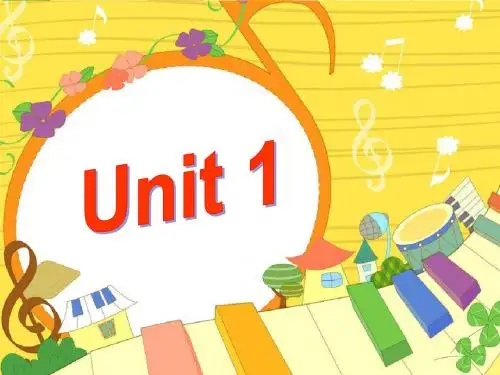
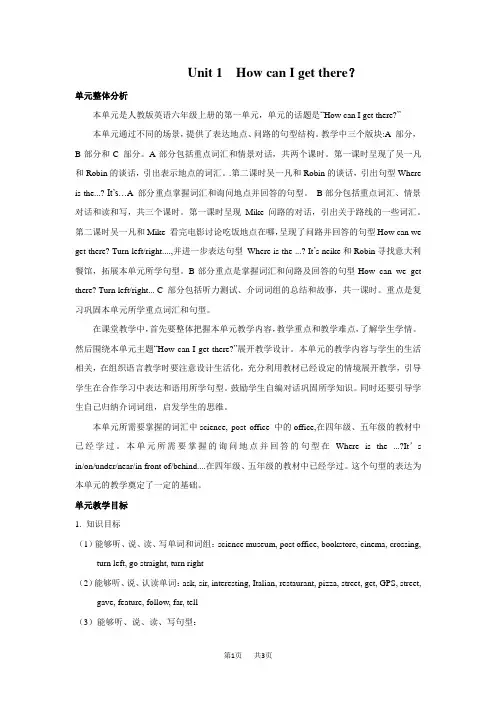
Unit 1 How can I get there?单元整体分析本单元是人教版英语六年级上册的第一单元,单元的话题是“How can I get there?”本单元通过不同的场景,提供了表达地点、问路的句型结构。
教学中三个版块:A 部分,B部分和C 部分。
A部分包括重点词汇和情景对话,共两个课时。
第一课时呈现了吴一凡和Robin的谈话,引出表示地点的词汇。
.第二课时吴一凡和Robin的谈话,引出句型Where is the...? It’s…A 部分重点掌握词汇和询问地点并回答的句型。
B部分包括重点词汇、情景对话和读和写,共三个课时。
第一课时呈现Mike问路的对话,引出关于路线的一些词汇。
第二课时吴一凡和Mike 看完电影讨论吃饭地点在哪,呈现了问路并回答的句型How can we get there? Turn left/right....,并进一步表达句型Where is the ...? It’s neike和Robin寻找意大利餐馆,拓展本单元所学句型。
B部分重点是掌握词汇和问路及回答的句型How can we get there? Turn left/right... C 部分包括听力测试、介词词组的总结和故事,共一课时。
重点是复习巩固本单元所学重点词汇和句型。
在课堂教学中,首先要整体把握本单元教学内容,教学重点和教学难点,了解学生学情。
然后围绕本单元主题“How can I get there?”展开教学设计。
本单元的教学内容与学生的生活相关,在组织语言教学时要注意设计生活化,充分利用教材已经设定的情境展开教学,引导学生在合作学习中表达和语用所学句型。
鼓励学生自编对话巩固所学知识。
同时还要引导学生自己归纳介词词组,启发学生的思维。
本单元所需要掌握的词汇中science, post office 中的office,在四年级、五年级的教材中已经学过。
本单元所需要掌握的询问地点并回答的句型在Where is the ...?It’s in/on/under/near/in front of/behind....在四年级、五年级的教材中已经学过。
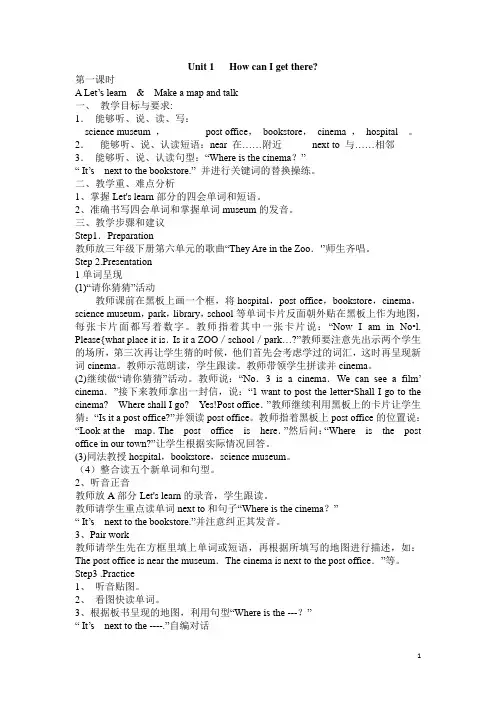
Unit 1 How can I get there?第一课时A Let’s learn & Make a map and talk一、教学目标与要求:1.能够听、说、读、写:science museum ,post office,bookstore,cinema ,hospital 。
2.能够听、说、认读短语:near 在……附近next to 与……相邻3.能够听、说、认读句型:“Where is the cinema?”“ It’s next to the bookstore.” 并进行关键词的替换操练。
二、教学重、难点分析1、掌握Let's learn部分的四会单词和短语。
2、准确书写四会单词和掌握单词museum的发音。
三、教学步骤和建议Step1.Preparation教师放三年级下册第六单元的歌曲“They Are in the Zoo.'’师生齐唱。
Step 2.Presentation1单词呈现(1)“请你猜猜”活动教师课前在黑板上画一个框,将hospital,post office,bookstore,cinema,science museum,park,library,school等单词卡片反面朝外贴在黑板上作为地图,每张卡片面都写着数字。
教师指着其中一张卡片说:“Now I am in No•l. Please{what place it is.Is it a ZOO/school/park…?”教师要注意先出示两个学生的场所,第三次再让学生猜的时候,他们首先会考虑学过的词汇,这时再呈现新词cinema。
教师示范朗读,学生跟读。
教师带领学生拼读并cinema。
(2)继续做“请你猜猜”活动。
教师说:“No.3 is a cinema.We can see a film’ cinema.”接下来教师拿出一封信,说:“1 want to post the letter•Shall I go to the cinema?Where shall I go?Yes!Post office.”教师继续利用黑板上的卡片让学生猜:“Is it a post office?”并领读post office。
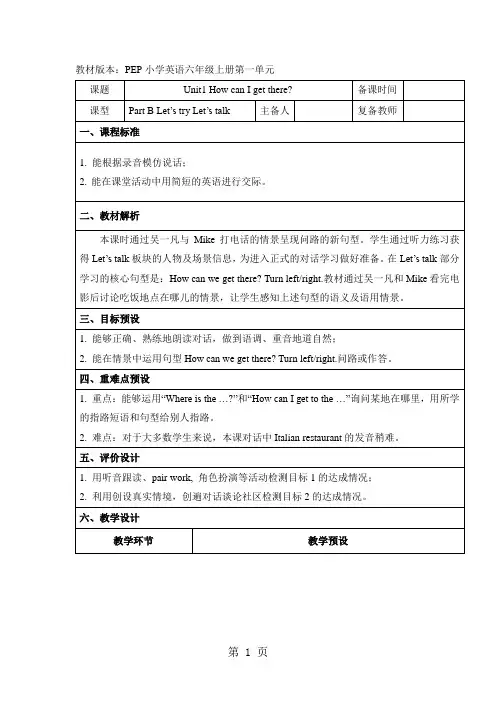
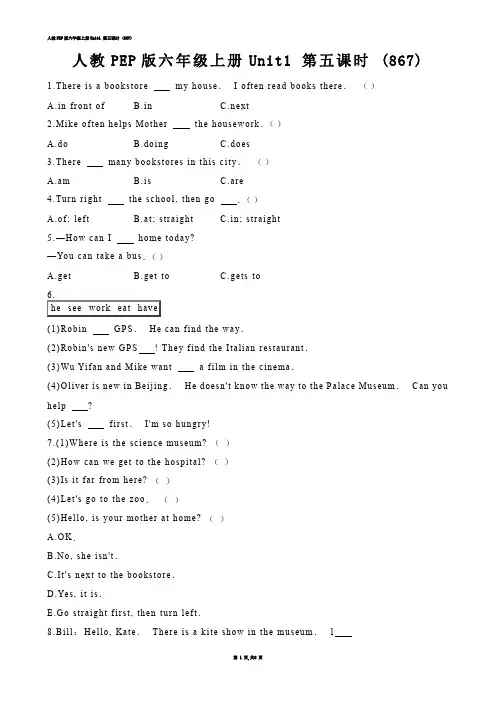
人教PEP版六年级上册Unit1 第五课时(867)1.Th e re is a b oo k s to r e my h o u s e.I o fte n r ea d b o ok s th e r e.()A.in f r on t o fB.inC.ne x t2.M ike o f te n h e lp s Mo th e r th e ho u s e wo r k.()A.d oB.do ingC.do e s3.Th e re ma n y b oo k s to re s in th is c ity.()A.a mB.isC.a re4.Tu r n r ig h t the s c h oo l,the n g o .()A.o f; le f tB.a t; s tr a ig h tC.in; s tr a ig h t5.—Ho w ca n I h ome to d a y?—Yo u c an ta ke a b us.()A.g e tB.ge t toC.ge ts to(1)Ro b in GP S.H e c an f ind the wa y.(2)Ro b in's n e w GP S! Th e y f in d th e Ita lia n r e s ta u r an t.(3)Wu Yif an a n d M ike wa n t a f ilm in th e c in e ma.(4)O live r is n e w in Beijin g.H e d oe s n't k no w th e wa y to th e P a lac e Mu s eu m.C an yo uh e lp ?(5)Le t's f ir s t.I'm s o h u n g r y!7.(1)W h e re is th e sc ien c e mu s eu m?()(2)Ho w ca n we ge t to th e ho s p ita l?()(3)Is it f a r f r o m h e r e?()(4)Le t's g o to th e z oo.()(5)He llo,is yo u r mo th e r a t h o me?()A.O K.B.N o,sh e isn't.C.It's n e x t to th e b oo ks to r e.D.Ye s,it is.E.G o s tr a igh t f ir s t,the n tu rn le f t.8.B ill:H e llo,Ka te.T h e r e is a k ite sh o w in th e mu s eu m.1Ka te:G re a t.I'd lik e to.2B ill:It's n e x t to th eC en tr a l P a r k(中心公园).Ka te:3B ill:Fir s t g o s tr a ig h t.Ne x t, tu r n le f t a t the p o s t o ff ice.4We c an s ee th eC en tr a l P a r k o n th e r ig h t.Go s tr a igh t an d we ca n s e e the mu s e u m.Ka te:Oh,I s e e.T ha n k yo u.B ill:5A.B u t wh e re is the mus e u m?B.T he n, tu r n r ig h t a t th e ho s p ita l.C.Is it f a r f ro m h e r e?D.Do yo u wa n t to go with me?E.H o w c an we g e t th er e?F.Yo u'r e we lc o me.G.C an yo u h e lp he r?(1)(2)(3)(4)(5)9.Wu Yif a n: R ob in, wh e r e is M ike's h o me?R ob in: It's n e x t to th e h o sp ita l.Wu Yif a n: Is th e r e a su p e r ma r k e t th e r e?R ob in: Ye s.T he r e is a s up e r ma r k e t in f r on t o f the ho s p ita l.Wu Yif a n: G o od.We c a n b u y s o me f r u it in th e s up e r ma r k e t.R ob in: Th e r e is a ls o a b o ok s to r e b e h in d M ike's h o me.We ca n go the r e a nd b u y s o me bo oks.(1)W he r e is M ike's h o me?()A.It's n e x t to th e p os t o ff ic e.B.It's n e a r the ho s p ital.C.It's b e h ind th e ho s pita l.(2)W ha t ca n th e y b u y in th e s u pe r ma r k e t?()A.S o me f r u it.B.S o me bo o k s.C.S o me ve g e tab le s.(3)Th e is b e h in d th e su p e r ma r ke t.()A.c in e maB.lib ra r yC.ho s p ita l(4)M ik e's h o me is th e b oo k s to r e.()A.in f r on t o fB.be h in dC.ne x t to(5)Ca n th e y b u y b o o ks f r o m th e b o ok s to re?()A.S o r r y,I d o n't k n o w.B.Ye s,th e y c a n.C.N o,the y c a n't.10.T he r e is a ma p o f ou r c ity.T h e s c ien c e mu s e u m is n e x t to the b o ok s to r e a nd th e p o s t o ff ic e.T he b oo k s to re is be h ind th e c ine ma.Th e c ine ma is r o und (圆的) a nd b ig.The h o s p it a l is in f r o n t o f th e c in e ma.T h e lib ra r y is in f r o n t o f the sc ie n ce mu s e u m.T h e p a r k is n ex t to th e ho s pita l.T h e s ch oo l is nex t to the p a rk a n d the lib r a r y.T he p o s t o ff ic e is in f r on t o f th e s c hoo l.I a m n e a r the s ch o o l n o w.(1)Th e p o s t o ff ic e is n e x t t o th e s c ien c e mu s e u m.()(2)Th e h o sp ita l is be hin d the c ine ma.()(3)Th e sc h oo l is in f ro n t o f th e p a rk.()(4)Th e sc h oo l is in f ro n t o f th e p os t o ff ic e.()(5)I a m n e a r th e s ch oo l n o w.()11.(1)ge t to(2)p a s s b y(3)in f r on t o f(4)n ex t to(5)f o llo w me(6)a tou r gu id e(7)s e nd a p os tc a rd(8)邮局(9)左转(10)直走参考答案1.【答案】:A2.【答案】:A3.【答案】:C4.【答案】:B5.【答案】:A【解析】:get to 意为“到达”,后接地点名词,如get to the park 到达公园;如果后面接地点副词,to 则要省略,如get there/here/home到达那儿/这儿/家。
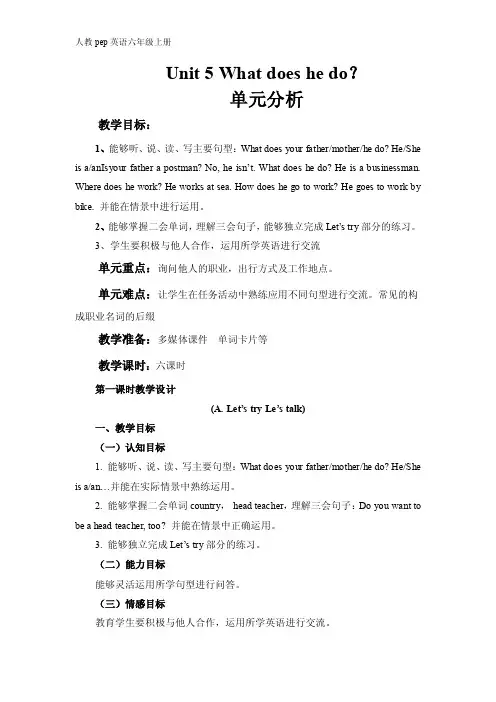
Unit 5 What does he do?单元分析教学目标:1、能够听、说、读、写主要句型:What does your father/mother/he do? He/She is a/an Isyour father a postman? No, he isn’t. What does he do? He is a businessman. Where does he work? He works at sea. How does he go to work? He goes to work by bike. 并能在情景中进行运用。
2、能够掌握二会单词,理解三会句子,能够独立完成Let’s try部分的练习。
3、学生要积极与他人合作,运用所学英语进行交流单元重点:询问他人的职业,出行方式及工作地点。
单元难点:让学生在任务活动中熟练应用不同句型进行交流。
常见的构成职业名词的后缀教学准备:多媒体课件单词卡片等教学课时:六课时第一课时教学设计(A. Let’s try Le’s talk)一、教学目标(一)认知目标1. 能够听、说、读、写主要句型:What does your father/mother/he do? He/She is a/an…并能在实际情景中熟练运用。
2. 能够掌握二会单词country,head teacher,理解三会句子:Do you want to be a head teacher, too? 并能在情景中正确运用。
3. 能够独立完成Let’s try部分的练习。
(二)能力目标能够灵活运用所学句型进行问答。
(三)情感目标教育学生要积极与他人合作,运用所学英语进行交流。
二、教学重难点(一)重点掌握四会句型What does your father/mother/he do? He/She is a/an...突破方法:反复朗读,情景对话,突破重点。
(二)难点能够听、说、认读拓展句型What are you going to be? I am going to be a/an...突破方法:小组对话、学生搭档对话、游戏等方式,突破难点。
人教精通版六年级上册英语教案第一课时:Unit 1 Hello!教学目标:1. 学生能够听、说、认读并能书写26个英文字母。
2. 学生能够用英语进行个人的自我介绍。
3. 学生能够灵活运用问候语相互交流。
教学重点:1. 学生能够正确地听、说、认读26个英文字母。
2. 学生能够用英语进行自我介绍。
教法:任务型教学法,情景教学法教学准备:PPT课件,挂图,音频设备,黑板教学过程:Step 1: Greeting (5 minutes)- T: Good morning, students!- Ss: Good morning, teacher!- T: How are you today?- Ss: I'm fine, thank you. And you?- T: I'm fine too. Thank you.Step 2: Presentation (15 minutes)- T: Now, let's learn the English alphabet. First, I'll show you the uppercase letters. (Teacher shows the PPT with the uppercase letters.)- T: Repeat after me and pay attention to the pronunciation. Let's go!- Ss: (Repeat after the teacher)- T: Great! Now, let's learn the lowercase letters. (Teacher shows the PPT with the lowercase letters.)- T: Repeat after me, and remember the shape of each letter. Let's go!- Ss: (Repeat after the teacher)Step 3: Practice (20 minutes)- T: Now, let's practice the letters together. I'll show you a letter, and you tell me its name and the sound it represents.- T: (Teacher shows a flashcard with a letter)- S1: It's "A". The sound is /æ/.- T: Excellent! Now, let's continue.- T: (Teacher shows another flashcard with a letter)- S2: It's "B". The sound is /b/.- T: Well done! Keep it up!- T: (Teacher continues showing flashcards and students provide answers accordingly.)Step 4: Introduction (10 minutes)- T: OK, now I want each of you to say your name and an English letter that starts with the same sound as your name.- T: For example, my name is Miss Smith, and I'll say "My name starts with 'S', just like 'Smith'."- S1: (Student says their name and an English letter)- T: Well done! Let's continue.Step 5: Role Play (15 minutes)- T: Now, let's practice some basic greetings and introductions. I'll give you different scenarios, and I want you to act them out in pairs.- T: Scenario 1: You meet a new classmate. Introduce yourselves and say hello.- T: Scenario 2: You meet your teacher in the morning. Greet your teacher and ask how he/she is doing.- T: Scenario 3: Your friend has just come back from a trip. Greet your friend and ask if he/she had a good time.- T: (Students work in pairs and perform the role play.)Step 6: Wrap-up and Homework (5 minutes)- T: Great job today, everyone! Remember to practice saying the letters and greetings every day. For homework, I want you to write a short paragraph introducing yourself in English. You can use the sample we practiced today as a reference.- T: That's all for today. See you next time!- Ss: Goodbye, Miss Smith!教学反思:本节课通过任务型教学法和情景教学法相结合,让学生在实际交流中学习英文字母的名称和发音,并能够进行简单的自我介绍和问候。
课时 5 Read and write ~ Let's wrap it up一、圈出下列每组中不同类的单词。
1.2.3.4.5.6.二、根据图片选择正确的介词(词组)填空。
1. There is a window________ the wall .2. The shoes are________ the bed .3. The ball is________ the bed .4. The picture is________ the window .5. I can see a dog________ the door .6. The chair is________ the door .三、单项选择。
( ) 1. Scientists________ the computer a new feature .A. givesB. gaveC. giving ( ) 2. Lily has a robot . It has many new________.A. featureB. featuresC. featuring() 3. —Why are you late today, Tina?—Because my bike doesn′t________.A. useB. workC. have() 4. Let′s________ straight and turn left .A. goB. goesC. go to() 5. There________ Tom .A. comeB. comesC. coming() 6. He can help the boys________ the Italian restaurant .A. findB. findsC. finding四、根据情景选择正确答案。
1. 当你想知道电影院的位置时,你应该问:_________A. What is the cinema?B. Where is the museum?C. Where is the cinema?2. 对方问你去商店怎么走,你告诉他可以在公园向右转,你应该说:________A. Turn right at the park .B. Turn left at the crossing .C. Go straight at the hospital .3. 你想告诉同伴意大利餐馆在博物馆后面,应说:________A. The zoo is behind the museum .B. The cinema is next to the museum .C. The Italian restaurant is behind the museum .4. 你想说动物园就在那里,应说:________A. There is the zoo!B. Is there the zoo?C. There is a park .5. 你想问Tom今天来上学时路过了多少地方,应说:________A. How much places did you pass by?B. How many places did you pass by?C. How many place did you pass by?五、选择合适的句子补全对话。
Unit 1 How can I get there?Part ALet’s try & Let’s talk【教学目标】1. 能够听、说、认读单词ask、sir和句型“Is there a…?”“I want to…”“What a great museum!”。
2.能在日常交际中询问别人某物在哪里,并能做出相应的回答,即能够灵活使用句型“Where is…?”“It’s+方位介词/介词短语”。
3.能完成“Let’s try”部分的听力任务。
4.提高学生合作学习的能力。
【教学重难点】重点:能听、说、认、读单词ask, sir及句型句型:Where is …? It’s +方位介词”“I want to … What a great museum!难点:1.能在日常交际中询问别人某物在哪里,并能做出相应的回答,即能够灵活使用句型“Where is …?”“It’s+方位介词/介词短语”。
2. 正确使用方位介词。
【课前准备】人物头饰、单词卡片、教学光盘【教学过程】Step 1:Warm-up教师用课件或其他方式展示一系列小球与盒子的图片,小球分别处在盒子的不同方位。
教师用图片带领学生复习句子:“Where is the ball?It's in/on/behind the box.”接着展示一张公园的图片,旁边是图书馆。
用课件展示或板书问句“Where is the park?”然后请学生尝试着看图回答问句。
答出“It's next to the library.”的学生要给予表扬或其他奖励。
Step 2: Presentation1.教师展示Robin在博物馆的图片,指着机器人说:“Who's that?”学生回答:“It's Robin.”再指着房子说:“Where can we find Robin?”学生回答:“In the museum.”教师出示感叹句:“What a great museum! ”2.教师出示一张明信片,说:“It's a postcard.Robin wants to send a postcard.Where should he go?”引出词组post office。
人教PEP 版六年级英语上册第一单元教案Unit1 How can I get there? 教学设计第一课时教学内容:A Let’s try Let’s talk C Let’s wrap it up教学目标:1.帮助学生理解对话,并学会运用句型“Where is the ...? ”问路。
2.帮助学生学会运用词组“near,next to, behind”等表述方位。
达到简单的交际。
教学重难点:重点:1. 句型:Where is the ...? It’s near/next to/behind ....2. 运用句型问路,表述方位。
难点:运用句型问路,表述方位。
教学准备:课件教学过程:1.Warm -- up师生自由问答:T: Hello, nice to meet you!Ss: Nice to meet you!T: What's the weather like today?Ss: It's sunny!T:Good!What's this in English?Ss:A book.T:Yes,It's my book.Where can we buy the book?Ss: The bookstore.2.Presentation and practice(精讲点拨)(1)在黑板上画一座房子和一个机器人,指着机器人说:Who’s that? 学生回答:It’s Robin. 再指着房子说:Where can we find Robin? 学生回答:In the museum. 出示感叹句:What a great museum!出示一张明信片,说:"It’s a post card.Robin wants to send a post card.Where should he go?”引出单词 post o ffice.出示一张地图,问学生:“Where is the post office?”出示单词:next to, near, behind.利用三个例句结合图片理解 next to, near, behind.(4)在学生理解三个方位介词后,小组活动,利用方位介词描述途中各个场馆的位置。
pep小学英语六年级上册unit1说课稿篇一:小学英语六年级上册第一单元说课稿PEP小学英语六年级上册Unit 1一、说教材:这节课的内容是PEP小学英语Book7Unit 1How Do You Go There?Part B Let’ s read(The Traffic Rules)。
如何询问和回答人们日常出行的方式,密联系。
并了解部分国家交通文化的典型差异。
二、说教学目标:1same, every country, right side, left side等新词组。
2、能力目标:培养学生3、了解不帮助学生理解句型In China, drivers drive on the right side of Australia, however, drivers drive on the left side of the road.难点:学生对文化差异的了解:在中国和美国等国家车辆靠右行驶,但在有些国家车辆靠左行驶,比如英国、澳大利亚等地。
四、说教法、学法:(一)TPR活动法:用TPR活动法生动愉快地让学生适应上课,开始进入状态,同时是一个对以前的学习内容的复习,为下面的学习内容做铺垫,为学生展开新内容提供知识基础,(二)词不离句(语境):(三)小组学习法:撞,作的意识和策略,学生也在独立与合作的交织中(四)练习法使学生将学习到的阅读(五)、实物教学法来呈现材料,激发学生的学习(一)Preparation准备活动。
由课前精彩一分钟引出教师的Chant(自我介绍,交通方式)学生按交通方式分为四组,此时拍手连环ChantGroup bike: I go to school by bike. How do you go to schoolGroup bus: I go to school by bus. How do you go to school??这一过程既是学生复习旧的语言知识,为下一步学习作好铺垫,也是通过TPR活动让学生把所有的注意力集中到课堂中来,为英语学习创造了一种良好的氛围。
第五课时
一、教学内容
Part B Read and write
二、教学目标
1.能够在图片、实物等的帮助下听、说并认读单词,能够理解并会用表示方位的介词和介词短语等表达某物在某处。
2.了解map、compass、GPS、stars等的作用。
三、教学重难点
本课时的教学重点和难点是会用表示方位的介词和介词短语等表达某物在某处。
四、教学准备
录音机、磁带。
五、教学过程
Step 1 热身(Warming-up)
1.Greeting
2.Free talk
T:I want to see a film.Is there a cinema near here?
S:Yes,there is.
T:Where is it?
S:It's next to the park.
T:How can I get there?
S:Turn left at the bookstore.Then turn right at the hospital.
T:Thank you.
S:You're welcome.
Step 2 新课呈现(Presentation)
师生交流生活中有哪些东西可以为我们指明方向,呈现单词left、right、GPS、compass、stars、map的图片并伴随读音。
1.教师提问:If you are in a car,which of these can help you find a place?随着学生的回答,课件中呈现GPS、compass、stars、map,初步了解这些单词的汉语意思和读音。
2.Listen and choose.听录音中Part B的Read and write 部分,选择正确的答案。
You are in a car.Which of these can help you find a place?Listen and choose。
教师播放录音,学生选择听到的答案。
3.教师领读单词,并让学生在四线格中尝试书写单词。
4.全班分成4个小组,各组同学在组内初读对话,解决不会读的单词和不理解的句子,小组内不能解决的问题可以询问老师。
5.Listen and order,让学生听录音,按课文呈现的顺序排序。
6.Read the text and answer the questions,让学生读课文对话并回答问题。
7.跟随录音读全文,全班齐读,小组内分角色朗读对话并尝试表演。
8.Fill in the blanks and retell the story.
Step 3 巩固与拓展(Consolidation and extension)
游戏:Where is it?
活动方式:将全班分成三组,第一组为“地点1”,第二组为“方位介词或短语”,第三组为“地点2”,每人按自己小组分的任务写一个相应的内容,准备好以后,每组派出一个代表,教师选一名学生完成句子。
如:The hospital is behind the school.
Step 4 总结(Summary)
六、课后反思
第六课时
一、教学内容
Part B Let's check & Let's wrap it up & Part C Story time 二、教学目标
1.复习巩固本单元所学的知识,检测掌握情况。
2.培养学生的听力能力。
3.能熟练运用next to、beside、near等方位词。
4.能理解Story time部分的故事。
三、教学重难点
1.复习巩固本单元所学的知识,检测掌握情况。
2.能熟练运用所学语言礼貌地问路和指路。
四、教学准备
图片、教学课件、光盘。
五、教学过程
Step 1 Warming-up
1.Greeting
2.齐唱本单元的歌曲。
Step 2 Let's check
首先,出示Let's check的挂图,让学生根据图片猜测画面的意思。
然后让学生浏览图下的两个问题,做到心中有数。
播放录音,让学生根据听到的内容回答两个问题,在学生听的过程中做适当的引导。
再次播放录音,让让学生跟读。
Step 3 Let's wrap it up
1.出示小熊挂图,引导学生说出表示不同方位的单词,并填在图中相应的椭圆色块里。
2.讲解next to、near、beside的用法区别。
然后鼓励学生用这些方位介词(短语)造句,看谁造得又多又快。
Step 4 Story time
把Story time部分的教学挂图呈现给学生,让学生先仔细看图,然后播放录音,适当停顿,结合图片给学生讲解故事内容。
再次播放录音,让学生模仿跟读。
在学生基本掌握
了故事大意之后,请几位同学到讲台前面进行表演,并让学生说一说从故事中学习到了什么经验。
Step 5 Summary
师生一起总结本课时的教学重点。
六、课后反思。